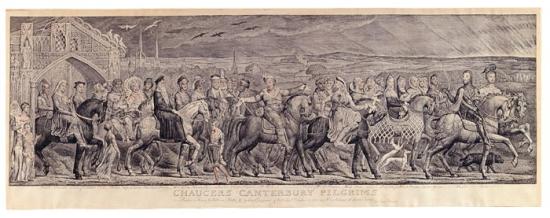
Chaucer's Canterbury Pilgrims
Copper engraving, with additions in watercolor by the artist
Third state, 1810–20
Copy 3P
Signature and imprint, Painted in Fresco by William Blake & by him Engraved & Published October 8. 1810, at No 28. Corner of Broad Street Golden Square; inscribed below: Chaucers Canterbury Pilgrims, and with the names of the pilgrims, Reeve, Chaucer, Clerk of Oxenford, Cook, Miller, Wife of Bath, Merchant, Parson, Man of Law, Plowman, Physician, Franklin, 2 Citizens, Shipman, The Host, Sompnour, Manciple, Pardoner, Monk, Friar, a Citizen, Lady Abbess, Nun, 3 Priests, Squires, Yeoman, Knight, Squire.
Gift of Charles Ryskamp in memory of Grace Lansing Lambert
This is a magnificent example of Blake's largest print, one of only three known impressions to which he added watercolor. The engraving is known in five states, and the present sheet is the only hand-colored example of the third state of the image. Blake's use of line engraving, emulating the styles of early printmakers Albrecht Dürer and Lucas van Leyden, evokes the character of Chaucer's poetry.
Blake painted the pilgrims after a quarrel with R. H. Cromek and Thomas Stothard regarding whether the commission had originally been Blake's. The painting was exhibited at his brother's Soho shop in 1809, and this engraving was created from it.
William Blake (1757–1827) occupies a unique place in the history of Western art. His creativity included both the visual and literary arts. In his lifetime he was best known as an engraver; now he is also recognized for his innovative poetry, printmaking, and painting. Blake's keen perception of the political and social climate found expression throughout his work. His strong sense of independence is evident in the complex mythology that he constructed in response to the age of revolution.
Blake was already recognized as an engraver at age twenty-five, when his first volume of poems appeared. At thirty-three, in The Marriage of Heaven and Hell, he audaciously claimed that his birth had marked the origin of a "new heaven" in which his own art would exemplify the creativity prefigured by Milton and Michelangelo. By that time, Blake, in one of his most productive periods, had already produced Songs of Innocence and was at work on a series of illuminated books. In 1818 he met John Linnell, a young painter and engraver, through whom a group of young artists became Blake's followers. Calling themselves the Ancients, they helped perpetuate Blake's influence for generations.
The Morgan's Blake collection—one of this country's most distinguished—began with purchases as early as 1899 by Pierpont Morgan. During the tenure of Charles Ryskamp, director from 1969 to 1986, major gifts almost doubled the size of its Blake holdings. In recent years Ryskamp's own gifts of engravings, letters, and related materials have significantly enriched its scholarly resources.
I. Engravings
William Blake was tutored by his mother, given drawing lessons at the age of ten, and at fifteen apprenticed to James Basire, one of the most prominent engravers of the day. Seven years later, when the apprenticeship was complete, Blake was admitted to study at the Royal Academy. Because of this solid instruction, he was admired for his craftsmanship and often identified as "Mr. Blake, the engraver." Throughout his life, he maintained that engraving was a true art form: "Painting is Drawing on Canvas & Engraving is drawing on Copper & Nothing Else." Blake's prints demonstrate his strong commitment to line, developed through Basire and enhanced by his own creativity. Fortunately his engraver's training would support him, though not well, for the remainder of his life. At forty-six, he wrote, "I curse & bless Engraving alternately because it takes so much time & is so untractable, tho capable of such beauty & perfection."
This online exhibition is presented in conjunction with the exhibition William Blake's World: "A New Heaven Is Begun" on view September 11, 2009, through January 3, 2010.
This exhibition is made possible through the generosity of Fay and Geoffrey Elliott.
